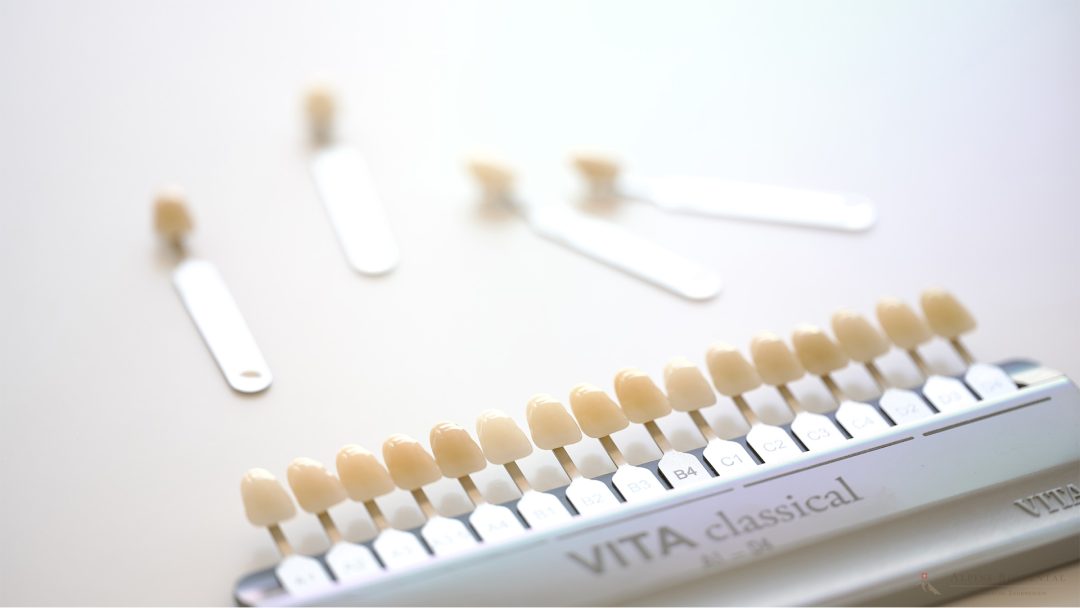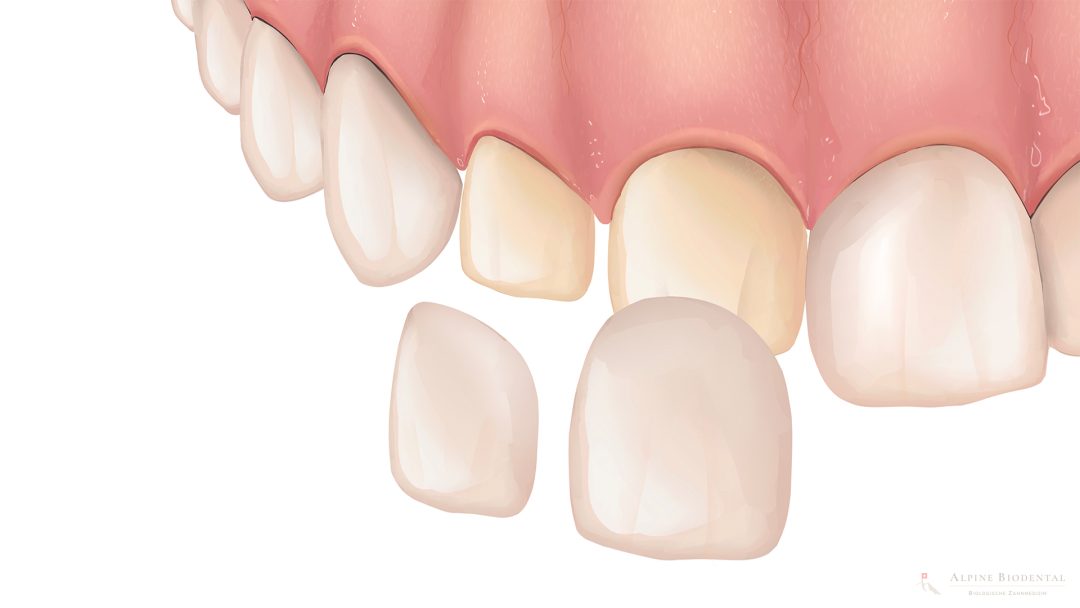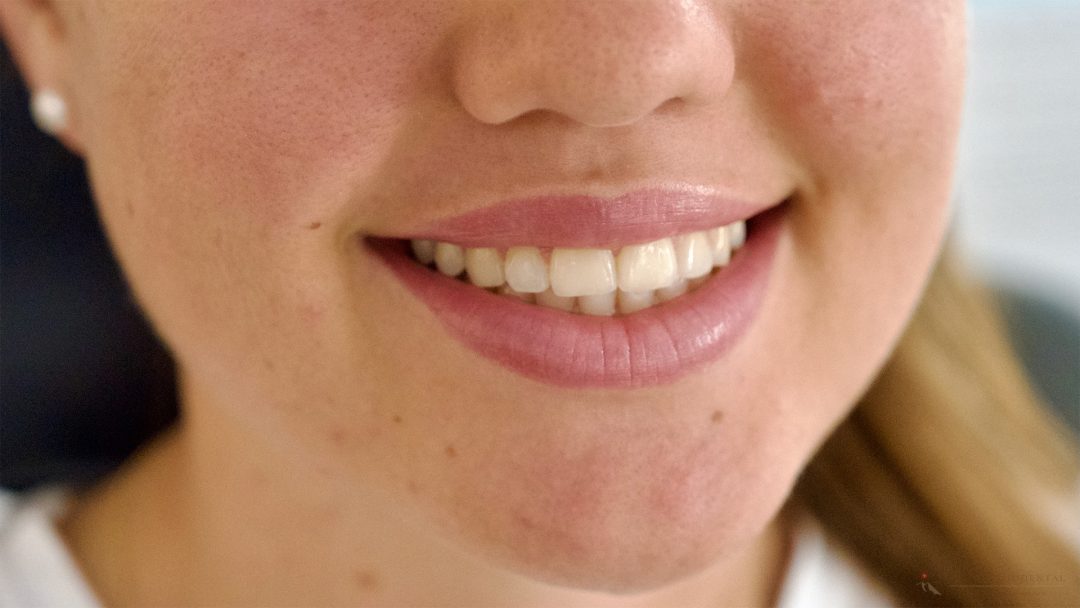Beautiful Teeth - Dental Aesthetics

Dental aesthetics deals with the appearance of teeth and gums and is what people mean when they talk about “beautiful teeth”. The aim is to achieve a beautiful and harmonious smile that reflects naturalness and health.
Dental aesthetics is also known as aesthetic dentistry and combines various options to restore beautiful teeth and a perfect smile.
Thanks to the variety of techniques, beautiful teeth can be recreated, although the actual situation has little to do with health.
In this article you will learn everything important about the potential, but also the limits of dental aesthetics.
Veneers
Veneers are thin ceramic shells that give the front teeth a beautiful and natural look.

Bleaching
Bleaching is a method that whitens up discolored teeth.

Beautiful Teeth and Gums - an inseparable Unit
Imagine a person with the most beautiful teeth, but their gums appear unhealthy and have receded. Such a sight lacks aesthetic appeal.
Teeth and gums form an inseparable unit known as Red-White Aesthetics. Both components must be healthy and in harmony for the dentition to be considered attractive and beautiful.
Several factors can harm teeth and gums. It’s crucial to be aware of these points.
For Excellent Dental Aesthetics, the Following is Important:
- Experienced and Cohesive Team of Dentists:
A team of skilled dentists working seamlessly together is essential. - Experienced Dental Technician:
A skilled dental technician working closely with the dental team, proficient in handling ceramic materials.
Our team of experts, combined with an in-house dental laboratory, ensures optimal aesthetic results even in complex restorations.
Factors that can affect Gum Health
There are various influences that can make the gums ill in the long term, causing teeth to look unattractive and unhealthy. One widespread problem is gingivitis.
In the following points, we look at all the factors that can damage the gums.
Unhealthy Bacterial Flora
Bacteria in the oral flora that can destroy gum tissue lead to pathological changes. The connection to the tooth weakens, creating deep gum pockets. Bacteria, metabolic products, and toxins enter the bloodstream through these pockets, putting a strain on the body.
Signs include softened, reddened gums that bleed easily and bacterial plaque along the gum line.
Anatomically Flawed Inlays and Crowns
Broken teeth are restored with plastic fillings, ceramic inlays or ceramic crowns. When reconstructing teeth, it is very important that the correct anatomy of the teeth is reproduced, as otherwise this can lead to problems with the gums, among other things.
For example, a lack of contact between the teeth can lead to food debris getting stuck there and constantly irritating the corresponding interdental space.
Steps or protrusions can also create a dirty niche where food and debris can remain.
Incorrect Brushing Technique
A toothbrush that is too hard combined with too much pressure can permanently traumatize the gums and cause them to recede.
Electric toothbrushes can also lead to permanent gum recession, especially if the bristles are too hard.
We therefore recommend using super soft manual toothbrushes.
Interdental brushes, small wooden brushes and dental floss lead to daily pressure on the fine dental papilla. Every tissue reacts to pressure by breaking down. This is no different for the gingiva. There is a gradual loss of the gingival papilla, which becomes noticeable as “black triangles”.
You should be very careful when using dental floss, brushes and anything else you use to reach between the teeth. After the loss of the papilla, dirty areas remain where plaque and food debris can easily get stuck. Esthetic reconstruction of “black triangles” is possible, but expensive.
In our experience, patients who have an optimal bacterial flora in the oral cavity and whose correct tooth anatomy has been restored no longer require dental floss or similar.
Health Problematic Materials
In dentistry, there are various materials that gums do not like to attach to and do not form a tight bond. However, as a tight attachment is very important for health and esthetics, the materials should be selected accordingly. Problematic materials include metals such as amalgam, gold or titanium. Plastics are also reluctantly chosen by the gingival cells for attachment.
Various studies have shown that ceramic is the material of choice in order to achieve a strong bond and not provoke gingivitis. Zirconium ceramic shows the best biology. The gingiva attaches firmly to a zirconia ceramic restoration and forms tight epithelial fibers.
Smoking and Gum Health
Zähne und Zahnfleisch kommen direkt mit dem Rauch in Kontakt und sind entsprechend sehr stark belastet. Patienten, die rauchen, haben häufig Probleme mit dem Zahnfleisch. Es kommt vermehrt zu Zahnfleischrückgang mit Ausbildung von “schwarzen Dreiecken” und optisch lang wirkenden Zähnen.
Ausserdem leiden Raucher vermehrt unter chronischen Entzündungen mit tiefen Zahnfleischtaschen.
Teeth – The White Aesthetics
Teeth are the hardest tissue in the human body and are responsible for grinding food. They are individual organs that are supplied with blood vessels, nerves and lymphatic capillaries.
The specific shape of the individual teeth, which differ only slightly from person to person, arises from their function of grinding food.
Healthy and anatomically correct teeth harmonize with a person’s appearance. Broader faces often have more massive tooth shapes than slim and petite people. This must be taken into account when providing dental care.
An esthetically pleasing set of teeth shows an anatomically correctly arranged dental arch, which supports the lips, cheeks and jaw joints and gives a youthful appearance.
Healthy teeth should always be preserved by the dentist. Sick teeth, on the other hand, should be replaced, preferably with ceramic implants. Gaps between teeth can lower the bite and make the face look sunken.
With every dental restoration (fillings, inlays, crowns, ceramic implants), the correct tooth anatomy should always be restored. This ensures that both the esthetics and the function are correct.
An extreme example of incorrect function due to the bite anatomy is TMJ. The incorrect bite forces the temporomandibular joints into an unphysiological position, resulting in tissue remodeling and various TMJ symptoms. As long as the bite is not corrected, the disease and all its stressful symptoms will persist.
What Can Damage Teeth
Teeth can also be damaged by various influences, which should be avoided at all costs if you want to keep beautiful teeth. In the following list you will find the factors that can damage your teeth.
High Levels of Cariogenic and Periodontal Bacteria
This is one of the main reasons why teeth break down over time.
The caries bacteria produce acids from sugar and etch holes in the teeth, which become visible as caries. The dentist gradually places more and more fillings. The fillings become larger over the course of a lifetime until the tooth has to be crowned or even extracted.
Periodontitis bacteria ensure that periodontitis manifests itself and the anchoring of the tooth is gradually broken down until the tooth loses its hold.
It is therefore very important to start at this point and optimize the oral flora in the mouth. This can greatly reduce the destruction in the oral cavity.
Incorrect Toothbrushing Technique
Brushing your teeth with toothbrushes that are too hard and apply too much pressure can rub away the surface layer of the teeth, making them look thinner and aesthetically unappealing.
Very soft toothbrushes can be gentle on teeth and gums. It is best to use a manual toothbrush. An electric ultrasonic toothbrush with a soft brush head can also be used if necessary.
Grinding and Clenching
Grinding and clenching is a common problem for many people these days. The masticatory system is used as a valve to deal with stress and release pent-up energy. This results in enormous forces being exerted on the teeth and jaw joints.
People who grind their teeth gradually wear away the enamel, leading to aesthetic and functional problems.
Aesthetics suffer as the natural shape of the teeth is lost and the teeth appear too short. In addition, there is a loss of support of the lower jaw – in other words, the lower jaw moves closer to the upper jaw, causing the facial profile to lose its youthfulness.
Function is disrupted as the temporomandibular joints experience unnatural forces and have to adapt. This adaptation leads to an influence on all skeletal, muscular and fascial structures of the body, which can result in an imbalance. This imbalance manifests itself in the form of TMJ symptoms.
Find out more about TMJ.
Smoking and Tooth Decay
Smoking not only damages the gums, but also the teeth. Smoking reduces saliva production and the oxygen content in saliva decreases.
In addition, smokers show more oxidative stress in their saliva.
As a result, people who smoke have a higher risk of tooth decay and more broken teeth.
Dental Aesthetics and Function
Beautiful teeth are important. However, a patient will not be satisfied if the function of the masticatory system suffers under dental aesthetics. The patient wants to be able to bite correctly without disturbing tooth contacts causing hindrance.
Therefore, function must be considered in every dental treatment and goes hand in hand with aesthetics.
The restoration of the correct function of the masticatory system always depends on achieving the ideal anatomy of tooth alignment, tooth shape, and bite height.
These optimal anatomical conditions always lead to correct function.
In these cases, function and aesthetics are particularly important and complex in implementation:
- In patients with TMJ (Temporomandibular Disorder of the Joint), the temporomandibular joints and surrounding tissues must be regenerated, and the anatomically correct bite restored.
- In edentulous patients requiring fixed implant-supported restorations. Here, the correct bite height, anatomically correct dental arches, and tooth forms with precise tooth contacts must be reconstructed to achieve the best possible aesthetics for the patient.
- In patients with significant bone loss due to accidents or bone infections.
Cooperation between Various Specialists
In aesthetic dentistry, it is crucial for dentists with different specialties to collaborate closely to achieve the ideal aesthetic and functional outcome. This approach allows complex cases to be treated with an ideal aesthetic and functional result.
Periodontology
Dentists specializing in periodontology focus on creating aesthetic and healthy gingiva. The foundation of this is an ideal oral flora.
Oral Surgery
Dentists in oral surgery are responsible for the removal of damaged and diseased teeth and the placement of ceramic implants in the most aesthetically pleasing position. Periodontal surgical enhancements of bone and gum can also be performed. If there is a lack of jawbone in height and width, it can be reconstructed with autogenous bone through oral surgery. Oral surgery is an essential part of aesthetic dentistry.
Prosthodontics
Implants and anatomically incorrect tooth forms are prosthetically restored with ceramic inlays/onlays or crowns. The individually correct anatomy of the teeth must be created, optimizing both the tooth form with correct contact points and the tooth alignment in the dental arch in relation to each other to enhance the function of the masticatory system and the appearance of the face.
Orthodontics
In complex situations, the orthodontist can harmonize the teeth in their position before implants are placed and dental restorations are created. This can result in an excellent outcome even in elaborate rehabilitations.
Dental Technology
For a perfect aesthetic result, a dental technician with extensive experience and artistic talent is necessary. As ceramic is the material of choice, a high level of expertise with this material is a prerequisite for maximum aesthetics.
Techniques for Beautiful Teeth
In aesthetic dentistry, various techniques and options exist for achieving beautiful teeth. The focus is on improving tooth shape, tooth alignment, tooth color, and dental health.
Bleaching/Teeth Whitening
Teeth darken with age despite regular professional cleanings. Therefore, a bright smile is often associated with health and youthfulness. Bleaching is a method to lighten the natural tooth structure and improve aesthetics.
In our dental practice, we can achieve a mild bleaching with plasma and ozone. This method is non-invasive, gentle on the gums, and does not cause tooth sensitivity.
Veneers and Lumineers/Non-Prep Veneers
Veneers are ceramic shells permanently bonded to the front teeth, enhancing the aesthetics of shape, color, and tooth structure. Conventional veneers are approximately 0.7 to 1 mm thick, requiring some tooth preparation.
Lumineers, also known as Non-Prep Veneers, are ultra-thin ceramic shells, only about 0.3mm thick. Often, there is no need for prior tooth preparation.
It is crucial with veneers to avoid any disruptive overloads on the ceramic shells. Therefore, a thorough examination of the masticatory system should be conducted beforehand.
Aesthetic Dentistry and Ceramic Implants
Ceramic implants are made of zirconia. They offer not only health advantages over traditional titanium implants but also significant gains in aesthetics.
- Gums and bone adhere firmly to zirconia ceramics. Since no pocket forms, gum inflammation occurs less frequently, and the red aesthetics appear natural and healthy.
- Less bacterial biofilm adheres to zirconia ceramics compared to titanium or natural teeth. This results in a lower tendency for inflammation, reflecting in the natural pink aesthetics.
- The white, tooth-like color of ceramic does not appear disruptive and is not associated with illness. Even if part of the ceramic implant is visible without coverage, it has no negative aesthetic impact. In contrast, titanium implants have a metallic-gray color that can show through the gums. If the upper portion is uncovered, it quickly becomes noticeable and negatively affects aesthetics.
Crowns and Bridges in Ceramic
Ceramic crowns and bridges exhibit the best aesthetics and should be preferred. Especially zirconia ceramics show optimal results concerning gum attachment, preventing the formation of gum pockets and the infiltration of bacteria into the bone.
Even in simple ceramic crowns and bridges, all aspects of aesthetics, biology, anatomy, and function must be considered.
With our in-house dental laboratory, we can place zirconia ceramic crowns and bridges in one appointment. This eliminates the need for patients traveling from afar to make an additional trip.
Ceramic Inlays and Aesthetics
Ceramic fillings surpass traditional composite fillings in terms of health and aesthetics.
These ceramic fillings can be precisely and high-quality manufactured in the dental laboratory or with the CEREC system and placed on the same treatment day.
Amalgam Removal/Amalgam Sanitation
Amalgam, due to its biological compatibility and aesthetic disadvantages, should be removed under effective protective measures. After amalgam removal, teeth can be restored with laboratory-made ceramic inlays in one treatment session.
Orthodontics – Transparent Aligners
Orthodontics aims to rearrange teeth in a harmonious and anatomically correct arch, improving the smile and facial profile aesthetically. The function of the entire chewing system should be enhanced, not deteriorated, through orthodontics.
Many cases can be treated with transparent aligners (e.g. Invisalign®), allowing patients to avoid wearing visible appliances.
Unfortunately, we often observe that improperly planned and executed orthodontics can lead to functional issues in patients. Over time, individuals may develop various symptoms of CMD, necessitating a correctly performed treatment of their masticatory system.
Experienced Dental Technician
The dental technician restores the lost piece of the tooth in the laboratory and plays a crucial role in the treatment process. The manufactured piece can be an inlay, crown, or bridge, and it should integrate perfectly into the patient’s dentition in terms of color, structure, and form.
All functional characteristics, such as occlusal contacts, shape in relation to neighboring teeth, and surface texture, should be considered optimally.
Dentists and dental technicians should work seamlessly and know exactly what to consider to avoid weaknesses in the treatment and manufacturing chain.
The patient’s case should be planned jointly by dentists and dental technicians. Through close collaboration and short communication channels, errors in communication and execution can be minimized. Therefore, it is a significant advantage if the dental technician is located directly in the dental practice and can focus solely on the patients of the practice.
Dr. Artur Hein
A dental prosthesis should always be aesthetic and look absolutely natural. Our team will be happy to help you.

FAQ’s on Beautiful Teeth and Dental Aesthetics
Beautiful teeth are very important in today’s society and are part of a healthy and well-groomed appearance. As there are many uncertainties on this topic, we strive to answer your questions as best as we can.
An aesthetic smile may look healthy, but it does not mean that the person is actually healthy. Methods such as bleaching, veneers or crowns can be used to visually conceal diseased and inflamed teeth.
Yes, gingiva has the ability to grow along healthy tooth structure or zirconium ceramic and fill cavities again. However, this only happens as long as the jawbone in the area is intact and the gingiva is not prevented from growing by stimuli.
No, tooth color varies from person to person, so some people naturally have a dark tooth color. In today’s society, light-colored teeth tend to be associated with health and beauty. This is the reason why many people want teeth that are too light in color.
White spots on the enamel are difficult to cover with resin. If the stains bother the patient too much, thin ceramic veneers can be a suitable solution.
The best prophylaxis for permanently healthy teeth is a healthy bacterial flora in the oral cavity. Dental hygiene alone is not enough. For more detailed information, please contact our team.
In order to produce natural and attractive dentures, the dentist needs a lot of experience and a well-coordinated team of experts in oral surgery, TMJ and dental technology.
Further information
Here you will find further information on the subject for a deeper insight.

